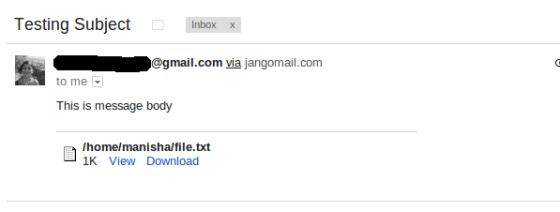
- JavaMail API Tutorial
- JavaMail - Home
- JavaMail API - Overview
- JavaMail - Environment Setup
- JavaMail - Core Classes
- JavaMail - Sending Emails
- JavaMail - Checking Emails
- JavaMail - Fetching Emails
- JavaMail - Authentication
- JavaMail - Replying Emails
- JavaMail - Forwarding Emails
- JavaMail - Deleting Emails
- JavaMail - Gmail SMTP server
- JavaMail - Folder Management
- JavaMail - Quota Management
- JavaMail - Bounced Messages
- JavaMail API Protocols
- JavaMail - SMTP Servers
- JavaMail - IMAP Servers
- JavaMail - POP3 Servers
- JavaMail API Useful Resources
- JavaMail - Quick Guide
- JavaMail - Useful Resources
- JavaMail - Discussion
JavaMail API - Sending Email With Attachment
Here is an example to send an email with attachment from your machine. The file on local machine is file.txt placed at /home/manisha/. Here we have used JangoSMPT server via which emails are sent to our destination email address. The setup is explained in the Environment Setup chapter.
To send a email with an inline image, the steps followed are:
Get a Session
Create a default MimeMessage object and set From, To, Subject in the message.
Set the actual message as below:
messageBodyPart.setText("This is message body");Create a MimeMultipart object. Add the above messageBodyPart with actual message set in it, to this multipart object.
Next add the attachment by creating a Datahandler as follows:
messageBodyPart = new MimeBodyPart(); String filename = "/home/manisha/file.txt"; DataSource source = new FileDataSource(filename); messageBodyPart.setDataHandler(new DataHandler(source)); messageBodyPart.setFileName(filename); multipart.addBodyPart(messageBodyPart);
Next set the multipart in the message as follows:
message.setContent(multipart);
Send the message using the Transport object.
Create Java Class
Create a java class file SendAttachmentInEmail, the contents of which are as follows:
package com.tutorialspoint;
import java.util.Properties;
import javax.activation.DataHandler;
import javax.activation.DataSource;
import javax.activation.FileDataSource;
import javax.mail.BodyPart;
import javax.mail.Message;
import javax.mail.MessagingException;
import javax.mail.Multipart;
import javax.mail.PasswordAuthentication;
import javax.mail.Session;
import javax.mail.Transport;
import javax.mail.internet.InternetAddress;
import javax.mail.internet.MimeBodyPart;
import javax.mail.internet.MimeMessage;
import javax.mail.internet.MimeMultipart;
public class SendAttachmentInEmail {
public static void main(String[] args) {
// Recipient's email ID needs to be mentioned.
String to = "destinationemail@gmail.com";
// Sender's email ID needs to be mentioned
String from = "fromemail@gmail.com";
final String username = "manishaspatil";//change accordingly
final String password = "******";//change accordingly
// Assuming you are sending email through relay.jangosmtp.net
String host = "relay.jangosmtp.net";
Properties props = new Properties();
props.put("mail.smtp.auth", "true");
props.put("mail.smtp.starttls.enable", "true");
props.put("mail.smtp.host", host);
props.put("mail.smtp.port", "25");
// Get the Session object.
Session session = Session.getInstance(props,
new javax.mail.Authenticator() {
protected PasswordAuthentication getPasswordAuthentication() {
return new PasswordAuthentication(username, password);
}
});
try {
// Create a default MimeMessage object.
Message message = new MimeMessage(session);
// Set From: header field of the header.
message.setFrom(new InternetAddress(from));
// Set To: header field of the header.
message.setRecipients(Message.RecipientType.TO,
InternetAddress.parse(to));
// Set Subject: header field
message.setSubject("Testing Subject");
// Create the message part
BodyPart messageBodyPart = new MimeBodyPart();
// Now set the actual message
messageBodyPart.setText("This is message body");
// Create a multipar message
Multipart multipart = new MimeMultipart();
// Set text message part
multipart.addBodyPart(messageBodyPart);
// Part two is attachment
messageBodyPart = new MimeBodyPart();
String filename = "/home/manisha/file.txt";
DataSource source = new FileDataSource(filename);
messageBodyPart.setDataHandler(new DataHandler(source));
messageBodyPart.setFileName(filename);
multipart.addBodyPart(messageBodyPart);
// Send the complete message parts
message.setContent(multipart);
// Send message
Transport.send(message);
System.out.println("Sent message successfully....");
} catch (MessagingException e) {
throw new RuntimeException(e);
}
}
}
As we are using the SMTP server provided by the host provider JangoSMTP, we need to authenticate the username and password. The javax.mail.PasswordAuthentication class is used to authenticate the password.
Compile and Run
Now that our class is ready, let us compile the above class. I've saved the class SendAttachmentInEmail.java to directory : /home/manisha/JavaMailAPIExercise. We would need the jars javax.mail.jar and activation.jar in the classpath. Execute the command below to compile the class (both the jars are placed in /home/manisha/ directory) from command prompt:
javac -cp /home/manisha/activation.jar:/home/manisha/javax.mail.jar: SendAttachmentInEmail.java
Now that the class is compiled, execute the below command to run:
java -cp /home/manisha/activation.jar:/home/manisha/javax.mail.jar: SendAttachmentInEmail
Verify Output
You should see the following message on the command console:
Sent message successfully....
As I'm sending an email to my gmail address through JangoSMTP, the following mail would be received in my gmail account inbox:
